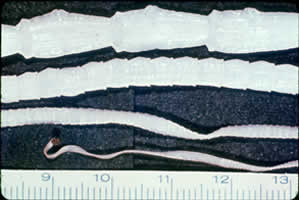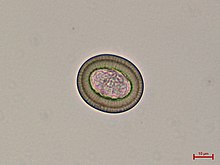Beef tapeworm
| Beef tapeworm | ||||||||||||
|---|---|---|---|---|---|---|---|---|---|---|---|---|

Beef tapeworm ( Taenia saginata ) |
||||||||||||
| Systematics | ||||||||||||
|
||||||||||||
| Scientific name | ||||||||||||
| Taenia saginata | ||||||||||||
| Goeze , 1782 |
The beef tapeworm ( Taenia saginata ), also known as bovine Finn tapeworm called, is a parasitic living tapeworm in the intestine of humans. Cattle serve as intermediate hosts .
distribution
The beef tapeworm was spread around the world with cattle breeding , but is now mostly found in the countries south of the Sahara and those of the Middle East . A particularly high prevalence is found in Kenya , where a study from 1996 found a regionally strongly fluctuating cysticercosis in 15–80% of the cattle.
Man is the only ultimate host .
features
The body of the beef tapeworm has all the typical characteristics of the tapeworm, it can reach a length of up to 12 meters and a width of up to 7 millimeters. A peculiarity of the beef tapeworm is the absence of the hook wreaths as an adherent organ on the scolex (head).
Life cycle
As with all tapeworms, the life cycle of the bovine tapeworm includes a fin stage ( Cysticercus bovis or Cysticercus inermis ), which can be found here in cattle ( cysticercosis ). The final human host excretes up to nine proglottids per day , these spread the eggs over long distances through active creeping movements . The eggs are ingested by cattle, where they primarily settle in the muscles of the diaphragm , tongue and heart . The Finns now remain in the cattle and are taken in by humans if they are not discovered during a meat inspection by the veterinarian , which is required by law in most countries . A worm infection only occurs if the meat is insufficiently cooked or eaten raw.
illness
The infection often remains without symptoms , rarely headaches, slight abdominal pain, feeling of hunger or changing appetite and malaise. Also, the only symptom may be weight loss. The whitish proglottids about 1 cm long and 0.7 cm wide can be found in human stool. The Finns do not produce any symptoms in cattle themselves.
prevention
Boiling or roasting the beef before consuming it can prevent infection. In order to kill the Zystizerken (Finns), a temperature of 65 degrees Celsius must be reached in the meat for at least five minutes. Freezing for nine days at minus ten degrees Celsius also kills the cysticerks. In Europe, up to 1.5 percent of cattle are infected. Untreated wastewater that ends up in rivers, “wild toilets” near pastures and the direct transmission of eggs from human to cattle on farms are sources of infection.
therapy
A single dose of praziquantel (10 mg / kg body weight) or niclosamide (2 g in adults) is effective when the human intestine is infected by the bovine tapeworm . Before the preparation was introduced in the 1980s, tin preparations were administered.
Web links
- Beef tapeworm infection in humans - information from the Robert Koch Institute
literature
- Johannes Dönges: Parasitology. With special consideration of human pathogenic forms . 2nd edition, Thieme, Stuttgart / New York, NY 1988, ISBN 3-13-579902-6 .
- Heinz Mehlhorn, Gerhard Piekarski: Outline of parasite science. Parasites of humans and farm animals 6th edition, Spektrum, Heidelberg 2002, ISBN 3-8274-1158-0 .
- Clinton A. White, F. Peter Weller in: Harrison's Internal Medicine. 16th edition. McGraw-Hill, London 2006, ISBN 3-936072-29-9 .
- Fritz H. Kayser: Medical Microbiology , 8th edition; Thieme, Stuttgart / New York, NY 1993, ISBN 3-13-444808-4 .
- Julia Walochnik (Author), Guido Walochnik (Illustrator): Hotel Mensch: Parasites - unwanted guests of our body. Ueberreuter, Vienna 2011, ISBN 978-3-8000-7492-1 .
Individual evidence
- ↑ Tapeworms on the move .
- ^ Marianne Abele-Horn: Antimicrobial Therapy. Decision support for the treatment and prophylaxis of infectious diseases. With the collaboration of Werner Heinz, Hartwig Klinker, Johann Schurz and August Stich, 2nd, revised and expanded edition. Peter Wiehl, Marburg 2009, ISBN 978-3-927219-14-4 , p. 290.
- ↑ Meyer, CJ: Handbook of Pharmacology as an explanation of all medicinal products contained in the Austrian Pharmacopoeia from 1834; C. Reichard, 1835; 414 pages; Page 195
